Abstract
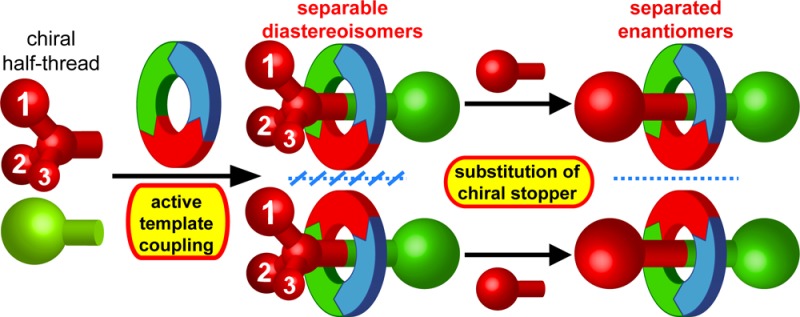
We describe the first method for production of mechanically planar chiral rotaxanes in excellent enantiopurity without the use of chiral separation techniques and, for the first time, unambiguously assign the absolute stereochemistry of the products. This proof-of-concept study, which employs a chiral pool sugar as the source of asymmetry and a high-yielding active template reaction for mechanical bond formation, finally opens the door to detailed investigation of these challenging targets.
As every chemistry student learns, molecular chirality can arise not only as a result of a tetrahedral carbon atom with four nonequivalent substituents but also due to elements of axial, planar, or helical chirality.1 It is less commonly appreciated that interlocked molecules can display optical activity as a direct result of the mechanical bond, even when the individual components are devoid of covalent chirality; for example, a [2]rotaxane in which the two ends of the thread are nonequivalent and the macrocycle is rotationally unsymmetrical (e.g., rotaxanes V, Figure 1) exists as a pair of enantiomers, depending on the relative orientation of macrocycle and thread.2−4
Figure 1.
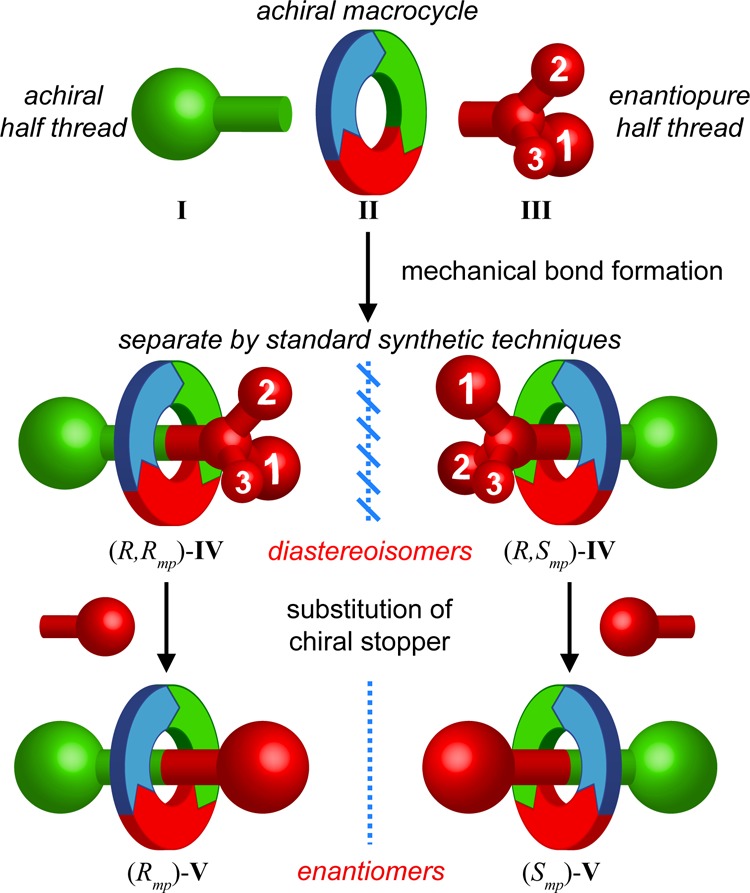
Schematic of our proposed approach to mechanically planar chiral rotaxanes. Stereochemical labels are arbitrary.
Vögtle et al. achieved the first isolation of such mechanically planar chiral [2]rotaxanes,5,6 and subsequently [1]-7 and [3]rotaxanes,8 in high enantiopurity using chiral stationary phase (CSP) HPLC to separate a racemic mixture of products. Studies on the resolved materials revealed high molar circular dichroism (CD), indicative of a well-expressed chiral environment.9 Later Kameta and Hiratani et al. employed a racemic mixture of mechanically planar chiral [2]rotaxanes to show that the environment formed between the thread and macrocycle can act as an effective chiral field for sensing applications.10
Despite these early successes, the synthesis of mechanically planar chiral rotaxanes remains an unsolved problem; the only enantioselective approach delivered the product in just 4% ee.11 Thus, to date, all syntheses of enantiopure materials have relied on preparative CSP-HPLC, which necessarily limits access to these intriguing molecules.12 With a view to opening up mechanically planar chiral rotaxanes to investigation in applications such as catalysis, host-guest chemistry, materials, and sensors, we set out to develop a simple method for their production using standard synthetic techniques.
We proposed an approach based on separating the mixture of diastereoisomeric [2]rotaxanes possessing the same covalent configuration but with opposite mechanical configuration (rotaxanes IV, Figure 1) that would result from an active template coupling of half-threads I and III mediated by macrocycle II.13,14 Substituting the chiral unit of the separated mechanical diastereoisomers IV with an achiral stopper unit, in a manner that does not affect the stereochemistry of the mechanical bond,15 would then give enantiopure rotaxanes V. Although separation of such mechanical diastereoisomers had not previously been reported,16−19 we recently observed the efficient transfer of chiral information between a chiral stopper unit and an achiral macrocycle in a sterically crowded rotaxane.20 We hypothesized that such efficient chiral information transfer would lead to mechanical diastereoisomers based on our “small” macrocycles to display significantly different physical properties and thus be separable using standard chromatographic methods.
Here we report a proof-of-concept study that demonstrates our new approach to these challenging molecules is not only feasible but extremely efficient, allowing access to a mechanically planar chiral rotaxane in high enantiopurity without the need for chiral separation techniques. Our approach also permitted us, for the first time, to assign the absolute stereochemistry of our separated mechanically planar chiral rotaxanes.
When rotationally unsymmetrical macrocycle 2 was employed in an active template copper-catalyzed azide-alkyne cycloaddition (AT-CuAAC)13b,20 with alkyne 1 and chiral azide 3 (Scheme 1), 1H NMR analysis of the crude reaction mixture indicated near complete conversion (>95%) of the macrocyclic component to a mixture of two interlocked products. Pleasingly, simple column chromatography on silica gel separated the mechanically interlocked products, which were unambiguously identified as mechanically diastereoisomeric rotaxanes 4 by single-crystal X-ray diffraction (XRD) (Figure 2). The two diastereoisomers were isolated in 43% and 45% yield, a combined isolated yield of mechanical bond formation of 88%. With samples of both diastereoisomers in hand, we examined the crude reaction mixture to reveal that they were formed in an equimolar ratio, in keeping with their isolated yields. Unfortunately, lowering the reaction temperature (20 °C) or varying the solvent employed (THF, MeCN, PhMe, CHCl3, EtOAc) did not lead to any observed diastereoselectivity.23
Scheme 1. AT-CuAAC Synthesis of Mechanically Diastereoisomeric Rotaxanes 4.
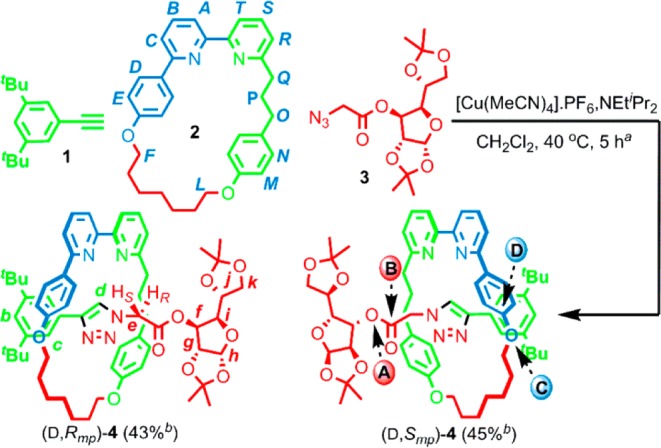
1 equiv 2, 1.5 equiv each 1 and 3, 0.96 equiv [Cu(MeCN)4]·PF6, and 10 equiv NEtiPr2.
Isolated yield after flash chromatography.
Figure 2.
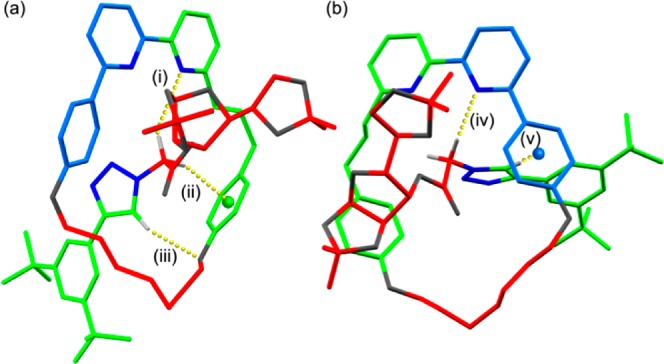
X-ray structures of (a) (d,Rmp)-4 and (b) (d,Smp)-4. Selected distances (Å): (i) 2.9, (ii) 2.5, (iii) 2.5, (iv) 2.3, and (v) 2.6.
Single-crystal XRD analysis of rotaxanes 4 allowed us to directly observe the relative orientation of macrocycle and thread and assign the absolute stereochemistry of the mechanical bond.22 To determine the mechanical stereochemistry, we assign atom priorities A→D based on the Cahn–Ingold–Prelog system as shown for (d-Smp)-4, where A is the highest priority atom in the thread and B is the highest priority point of difference in its ligands; atoms C and D are assigned similarly in the macrocycle. The molecule is then viewed along the A→B axis: if atoms C and D are disposed clockwise the stereochemistry is assigned as R; if atoms C and D are disposed anticlockwise the stereochemistry is assigned as S. Thus, the late-eluting diastereoisomer is assigned as (d,Rmp)-4 and the early-eluting diastereoisomer as (d,Smp)-4, where “d” refers to the covalent stereochemistry of the glucose unit and R/Smp refers to the mechanical planar chirality resulting from the orientation of the ring.23
The CD (Figure S1) and 1H NMR (Figure 3) spectra of rotaxanes 4 are significantly different, reflecting the expected strong interplay of the mechanical and covalent sources of chirality. Furthermore, with the caveat that solid-state structures are not necessarily representative of solution-state co-conformations, the non-covalent interactions observed by X-ray crystallography (Figure 2) provide surprisingly good explanations for some of the key differences in the 1H NMR spectra of rotaxanes 4.24 Most strikingly, the signals corresponding to He appear as well-separated doublets in 5.86 and 3.63 ppm in the Rmp isomer and 6.31 and 4.88 ppm in the Smp compound. In both cases, their X-ray structures suggests that one He is engaged in a CH–N hydrogen bond with a bipyridine nitrogen, with the CH–N contact in (d,Smp)-4 (2.3 Å) significantly shorter than for (d,Rmp)-4 (2.9 Å), which correlates with the larger relative deshielding of He in the Smp diastereoisomer. Similarly, the large relative shielding of one He in (d,Rmp)-4 (Δδ = 1.65 ppm) compared with the non-interlocked thread can be tentatively attributed to a close CH−π contact (2.5 Å) with the flanking aromatic ring that is not present in the X-ray structure of the Smp isomer (Δδ = 0.37 ppm). The X-ray structures also indicate that the deshielded He that participates in the CH–N hydrogen bond with the bipyridine nitrogen is He(S) in (d,Rmp)-4 but He(R) in (d,Smp)-4. Thus, the relative shift of the diastereotopic protons He in the two mechanical diastereoisomers is large: Δδ = 2.68 and 0.98 ppm for He(R) and He(S), respectively.
Figure 3.
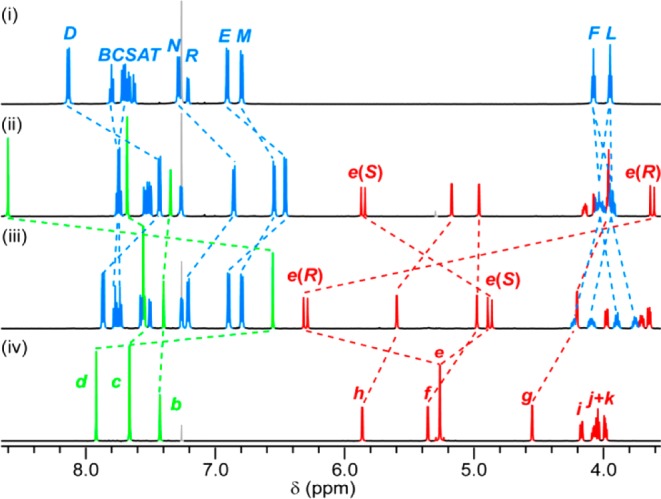
Partial 1H NMR (600 MHz, CDCl3, 300 K), with selected signals assigned, of (i) macrocycle 2, (ii) (d,Rmp)-4, (iii) (d,Smp)-4, and (iv) their corresponding non-interlocked thread. See the Supporting Information for full assignment. Labeling is as shown in Scheme 1. Residual solvent signals are shown in gray.
Having separated and fully characterized diastereoisomeric rotaxanes 4, we turned our attention to substituting the chiral glucose unit by an achiral amine. Although such substitution reactions of esters have previously been reported in rotaxane substrates under mild conditions,15b,15c,15e in the case of rotaxanes 4 they were unsuccessful, presumably due to the unactivated nature of the sugar leaving group and the highly sterically hindered environment of the mechanical bond. Ultimately, by treating rotaxanes 4 with amine 5, preactivated with AlMe3,25 and heating the reaction mixture for 16 h, we achieved complete consumption of the rotaxane starting materials to give mechanically planar chiral rotaxane 6 in 76% and 67% isolated yield from (d,Rmp)-4 and (d,Smp)-4, respectively (Scheme 2).
Scheme 2. Substitution of the Chiral Glucose Unit To Give Mechanically Planar Chiral Rotaxanes 6.
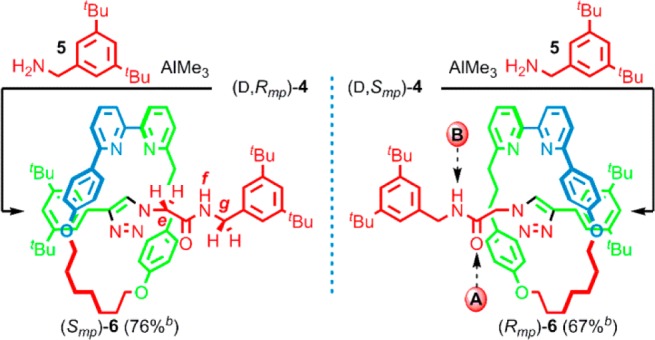
3.8 equiv 5, 2.5 equiv AlMe3, PhMe, 80 °C, 16 h.
Isolated yield after column chromatography.
The optical purities of rotaxanes 6 were confirmed by analytical CSP-HPLC (Figure 4a). Pleasingly, reaction of (d,Rmp)-4 gave rise to one enantiomer of rotaxane 6 in an er of 99.3:0.7, while reaction of (d,Smp)-4 gave the other as a single stereoisomer (>99.5:<0.5). As substitution of the glucose unit does not affect the relative orientation of the thread and macrocycle, the configuration of the mechanical bond in rotaxanes 6 can be assigned unambiguously. Thus, (d,Rmp)-4 and (d,Smp)-4 gives rise to rotaxanes (Smp)-6 and (Rmp)-6 in 98.6 and >99% ee, respectively.26 Inversion of the mechanical stereochemical label is due to formal inversion of the A→B axis as a result of substituting the glucose unit (Scheme 2).
Figure 4.
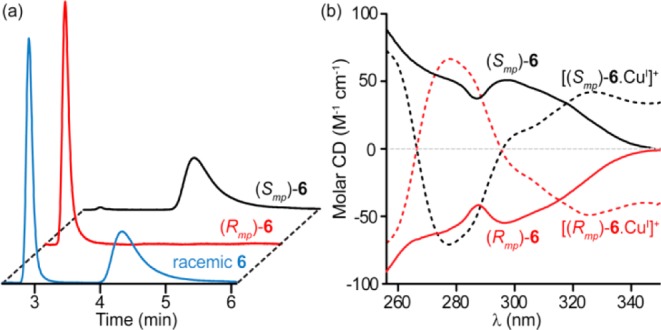
(a) CSP-HPLC and (b) CD analysis of 6 and [6·Cu]·PF6.
The enantiomeric nature of rotaxanes 6 is apparent from their CD spectra (Figure 4b), which are mirror images of one another. Re-introducing CuI into the macrocyclic ligand gave samples with more complex CD spectra in which the sign of the CD effect inverts at λ = 266 and 295 nm. In both cases the amplitude of the CD effect observed is relatively large.27 Furthermore, although the 1H NMR spectra of the enantiomers of rotaxane 6 are identical, comparison with the corresponding achiral, thread clearly demonstrates the chiral environment of the mechanical bond (Figure 5): He and Hg, which are enantiotopic in the thread, are diastereotopic in rotaxane 6, and both split into two widely separated signals. The significant deshielding of Hf in rotaxanes 6 compared to the non-interlocked thread is tentatively assigned to a hydrogen bond between the amide NH and the bipyridine unit, as previously described.13e
Figure 5.
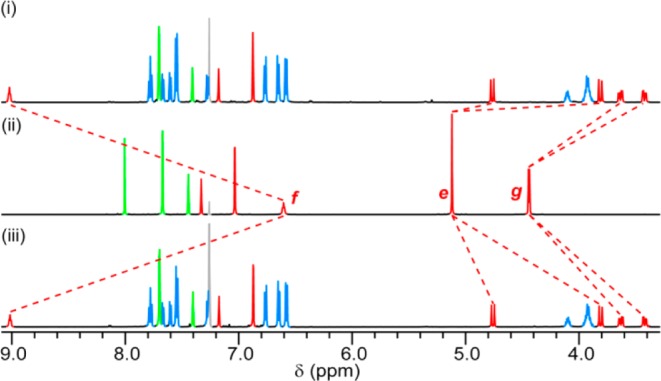
Partial 1H NMR (600 MHz, CDCl3, 300 K), with selected signals assigned, of (i) (Rmp)-6, (ii) their corresponding non-interlocked thread, and (iii) (Smp)-6. See the Supporting Information for the complete assignment. Labeling is as shown in Scheme 2. Residual solvent signals are shown in gray.
In conclusion, we have succeeded for the first time in synthesizing mechanically planar chiral rotaxanes in high enantiopurity without the need for chiral separation techniques. Our approach also allowed us to unambiguously assign the absolute stereochemistry of the mechanical bond, which had also not previously been achieved. Given the synthetic utility of the active template method for the synthesis of rotaxanes,13,14 this approach should prove general and, by avoiding the need for CSP-HPLC, scalable. Thus, these proof-of-concept studies open up this under-explored form of molecular asymmetry for study, and we anticipate that this will lead to exciting developments across a range of areas including materials, sensing, and catalysis. Ultimately, by combining mechanical chirality with the well-developed chemistry of rotaxane molecular shuttles, it may prove possible to realize molecular machines that display dynamic control over chiral space, such as switchable catalysts that can produce either hand of a desired product in response to external stimuli.28 Work toward these challenging objectives, as well as development of diastereoselective active template coupling reactions to deliver stereoselective chiral auxiliary methodologies for the synthesis of mechanically chiral molecules,23 is underway.
Acknowledgments
CSP-HPLC methods for the analysis of rotaxanes 6 were developed by Regis Technologies, Inc., and the authors are grateful to Ted Szczerba and Jelena Kocergin for their help. The authors thank Dan Pantoş of the University of Bath and John Viles of QMUL for assistance with the CD measurements. High-resolution mass spectroscopy was carried out by the EPSRC National Mass Spectroscopy Service in Swansea. X-ray crystallography was carried out at QMUL by Majid Motevalli. The authors are grateful to Fluorochem for the gift of reagents. This work was supported financially by the Royal Society and the EPSRC. S.M.G. is a Royal Society Research Fellow.
Supporting Information Available
Experimental details and characterization data. This material is available free of charge via the Internet at http://pubs.acs.org.
The authors declare no competing financial interest.
Supplementary Material
References
- Eliel E.; Wilen S.; Mander L.. Stereochemistry of Organic Compounds; John Wiley and Sons: New York, 1994. [Google Scholar]
- Schill G.Catenanes, Rotaxanes and Knots; Academic Press: New York, 1971. [Google Scholar]
- Catenanes and knots also display molecular chirality in the absence of covalent chirality although in their case molecular asymmetry can be the result of molecular topology, whereas rotaxanes are topologically trivial:; a Wasserman E.; Frisch H. L. J. Am. Chem. Soc. 1961, 83, 3789. [Google Scholar]; b Walba D. M. Tetrahedron 1985, 41, 3261. [Google Scholar]
- For recent reviews on the synthesis of mechanically interlocked molecules, including aspects of their mechanical stereochemistry, see:; a Beves J. E.; Blight B. A.; Campbell C. J.; Leigh D. A.; McBurney R. T. Angew. Chem., Int Ed. 2011, 50, 9260. [DOI] [PubMed] [Google Scholar]; b Forgan R. S.; Sauvage J.-P.; Stoddart J. F. Chem. Rev. 2011, 111, 5434. [DOI] [PubMed] [Google Scholar]; c Neal E. A.; Goldup S. M. Chem. Commun. 2014, 10.1039/C3CC47842D. [DOI] [PubMed] [Google Scholar]
- Although Schill proposed the term “cyclochiral” to describe mechanical asymmetry of the form exhibited by rotaxanes V,2 we feel this has the potential to lead to confusion, as the term properly belongs to the study of rotationally unsymmetrical cyclic molecules displaying multiple instances of asymmetry around the ring.1 Here we adopt the planar chiral interpretation, as proposed by Takata et al.11a
- Yamamoto C.; Okamoto Y.; Schmidt T.; Jager R.; Vögtle F. J. Am. Chem. Soc. 1997, 119, 10547. [Google Scholar]
- Reuter C.; Seel C.; Nieger M.; Vögtle F. Helv. Chim. Acta 2000, 83, 630. [Google Scholar]
- Schmieder R.; Hübner G.; Seel C.; Vögtle F. Angew. Chem., Int. Ed. 1999, 38, 3528. [DOI] [PubMed] [Google Scholar]
- Kishan M. R.; Parham A.; Schelhase F.; Yoneva A.; Silva G.; Chen X.; Okamoto Y.; Vögtle F. Angew. Chem., Int. Ed. 2006, 45, 7296. [DOI] [PubMed] [Google Scholar]
- Kameta N.; Nagawa Y.; Karikomi M.; Hiratani K. Chem. Commun. 2006, 3714. [DOI] [PubMed] [Google Scholar]
- a Makita Y.; Kihara N.; Nakakoji N.; Takata T.; Inagaki S.; Yamamoto C.; Okamoto Y. Chem. Lett. 2007, 36, 162. [Google Scholar]; For a recent attempted synthesis of mechanically planar chiral rotaxanes, see:; b Glen P. E.; O’Neill J. A. T.; Lee A.-L. Tetrahedron 2013, 69, 57. [Google Scholar]
- Although CSP-HPLC methods have proved successful,6−9 this approach is limited by the loading capacity of CSP columns and the need for specialized equipment and knowledge.
- For a recent review of the active template approach, see:; a Crowley J. D.; Goldup S. M.; Lee A.-L.; Leigh D. A; McBurney R. T. Chem. Soc 2009, 38, 1530. [DOI] [PubMed] [Google Scholar]; For selected examples of active template reactions for the synthesis of [2]rotaxanes, see:; b Aucagne V.; Hänni K. D.; Leigh D. A.; Lusby P. J.; Walker D. B. J. Am. Chem. Soc. 2006, 128, 2186. [DOI] [PubMed] [Google Scholar]; c Berná J.; Crowley J. D.; Goldup S. M.; Hänni K. D.; Lee A.-L.; Leigh D. A. Angew. Chem., Int. Ed. 2007, 46, 5709. [DOI] [PubMed] [Google Scholar]; d Crowley J. D.; Hänni K. D.; Lee A.; Leigh D. A. J. Am. Chem. Soc. 2007, 129, 12092. [DOI] [PubMed] [Google Scholar]; e Berná J.; Goldup S. M.; Lee A.-L.; Leigh D. A.; Symes M. D.; Teobaldi G.; Zerbetto F. Angew. Chem., Int. Ed. 2008, 47, 4392. [DOI] [PubMed] [Google Scholar]; f Goldup S. M.; Leigh D. A.; Lusby P. J.; McBurney R. T.; Slawin A. M. Z. Angew. Chem., Int. Ed. 2008, 47, 3381. [DOI] [PubMed] [Google Scholar]; g Crowley J. D.; Hänni K. D.; Leigh D. A.; Slawin A. M. Z. J. Am. Chem. Soc. 2010, 132, 5309. [DOI] [PubMed] [Google Scholar]; h Goldup S. M.; Leigh D. A.; McBurney R. T.; McGonigal P. R.; Plant A. Chem. Sci. 2010, 1, 383. [Google Scholar]; i Ugajin K.; Takahashi E.; Yamasaki R.; Mutoh Y.; Kasama T.; Saito S. Org. Lett. 2013, 15, 2684. [DOI] [PubMed] [Google Scholar]
- The active template approach has since been extended to the synthesis of other complex interlocked structures:; a Goldup S. M.; Leigh D. A.; Long T.; McGonigal P. R.; Symes M. D.; Wu J. J. Am. Chem. Soc. 2009, 131, 15924. [DOI] [PubMed] [Google Scholar]; b Sato Y.; Yamasaki R.; Saito S. Angew. Chem., Int. Ed. 2009, 48, 504. [DOI] [PubMed] [Google Scholar]; c Goldup S. M.; Leigh D. A.; McGonigal P. R.; Ronaldson V. E.; Slawin A. M. Z. J. Am. Chem. Soc. 2010, 132, 315. [DOI] [PubMed] [Google Scholar]; d Barran P. E.; Cole H. L.; Goldup S. M.; Leigh D. A.; McGonigal P. R.; Symes M. D.; Wu J.; Zengerle M. Angew. Chem., Int. Ed. 2011, 50, 12280. [DOI] [PubMed] [Google Scholar]; e Cheng H. M.; Leigh D. A.; Maffei F.; McGonigal P. R.; Slawin A. M. Z.; Wu J. J. Am. Chem. Soc. 2011, 133, 12298. [DOI] [PubMed] [Google Scholar]; f Winn J.; Pinczewska A.; Goldup S. M. J. Am. Chem. Soc. 2013, 135, 13318. [DOI] [PubMed] [Google Scholar]; g Hayashi R..; Wakatsuki K.; Yamasaki R.; Mutoh Y.; Kasama T.; Saito S. Chem. Commun. 2014, 50, 204. [DOI] [PubMed] [Google Scholar]
- Substitution of stopper units in rotaxanes using reactions that do not disrupt the mechanical bond were termed grafting reactions by Stoddart and co-workers:; a Rowan S. J.; Stoddart J. F. J. Am. Chem. Soc. 1999, 122, 164. [Google Scholar]; b Zehnder D. W. II; Smithrud D. B. Org. Lett. 2001, 16, 2485. [DOI] [PubMed] [Google Scholar]; c Hannam J. S.; Lacy S. M.; Leigh D. A.; Saiz C. G.; Slawin A. M. Z.; Stitchell S. G. Angew. Chem., Int. Ed. 2004, 43, 3260. [DOI] [PubMed] [Google Scholar]; d Kihara N.; Motoda S.; Yokozawa T.; Takata T. Org. Lett. 2005, 7, 1199. [DOI] [PubMed] [Google Scholar]; e Fernandes A.; Viterisi A.; Coutrot F.; Potok S.; Leigh D. A.; Aucagne V.; Papot S. Angew. Chem., Int. Ed. 2009, 48, 6443. [DOI] [PubMed] [Google Scholar]; f Altieri A.; Aucagne V.; Carrillo R.; Clarkson G. J.; D’Souza D. M.; Dunnett J. A.; Leigh D. A.; Mullen K. M. Chem. Sci. 2011, 2, 1922. [Google Scholar]
- Vögtle et al. synthesized a mixture of mechanically diastereoisomeric rotaxanes but did not report their separation:Schmidt T.; Schmieder R.; Müller W. M.; Kiupel B.; Vögtle F. Eur. J. Org. Chem. 1998, 2003. [Google Scholar]
- For selected examples where mechanical diastereoisomers are synthesized but their stereochemistry not discussed, see:; a Smukste I.; Smithrud D. B. J. Org. Chem. 2003, 68, 2547. [DOI] [PubMed] [Google Scholar]; b Sandanayaka A. S. D.; Sasabe H.; Araki Y.; Furusho Y.; Ito O.; Takata T. J. Phys. Chem. A 2004, 108, 9600. [DOI] [PubMed] [Google Scholar]; c Li X.-Q.; Jia M.-X.; Wang X.-Z.; Jiang X.-K.; Li Z.-T.; Chen G.-J.; Yu Y.-H. Tetrahedron 2005, 61, 9600. [Google Scholar]
- For examples of pseudo-[2]rotaxanes comprised of a rotationally unsymmetrical macrocycle and a chiral, unsymmetrical thread, see:; a Mobian P.; Banerji N.; Bernardinelli G.; Lacour J. Org. Biomol. Chem. 2006, 4, 224. [DOI] [PubMed] [Google Scholar]; b Hattori G.; Hori T.; Miyake Y.; Nishibayashi Y. J. Am. Chem. Soc. 2007, 129, 12930. [DOI] [PubMed] [Google Scholar]
- For knots and catenanes possessing topological and covalent chirality, see:; a Lukin O.; Yoneva A.; Vögtle F. Eur. J. Org. Chem. 2004, 2004, 1236. [Google Scholar]; b Perret-Aebi L.-E.; von Zelewsky A.; Dietrich-Buchecker C.; Sauvage J.-P. Angew. Chem., Int. Ed. 2004, 43, 4482. [DOI] [PubMed] [Google Scholar]
- Lahlali H.; Jobe K.; Watkinson M.; Goldup S. M. Angew. Chem., Int. Ed. 2011, 50, 4151. [DOI] [PubMed] [Google Scholar]
- Although there is no previous report in which the absolute stereochemistry of such chiral rotaxanes has been assigned, an IUPAC committee produced a working document on the assignment of mechanical stereochemistry in rotaxane systems: http://old.iupac.org/reports/provisional/abstract05/yerin_prs051216.pdf (accessed Oct 31, 2012).; Vögtle et al. also commented on methods for the assignment of their absolute configuration:Sobanski A.; Schmieder R.; Vögtle F. Chem. Uns. Z. 2000, 34, 160. [Google Scholar]
- We propose using the suffix “mp” to differentiate mechanical chirality from other sources of molecular asymmetry present.
- We originally described the sugar unit as a chiral auxiliary. However, during review it was correctly pointed out that, by definition, in the absence of stereoselectivity, it is not a chiral auxiliary but a chiral derivitizing agent that allows separation of the mechanical stereoisomers.1 We thank the reviewer for these insightful comments.
- The key intercomponent interactions observed using ROESY spectroscopy are in agreement with the solid state structures. See the Supporting Information.
- Basha A.; Lipton M.; Weinreb S. M. Tetrahedron Lett. 1977, 18, 4171. [Google Scholar]
- The slightly reduced enantiopurity of the S enantiomer is attributed to contamination of the (d,Rmp)-4 starting material with an extremely small quantity (∼0.7%) of the other diastereoisomer that was not detected by 1H NMR.
- Grimme S.; Harren J.; Sobanski A.; Vögtle F. Eur. J. Org. Chem. 1998, 1998, 1491. [Google Scholar]
- For a previous example of a small-molecule chiral catalyst that alters the sense of asymmetric induction in response to external stimuli, see:; a Wang J.; Feringa B. L. Science 2011, 331, 1429. [DOI] [PubMed] [Google Scholar]; For an example of an achiral switchable rotaxane catalyst, see:; b Blanco V.; Carlone A.; Hänni K. D.; Leigh D. A.; Lewandowski B. Angew. Chem., Int. Ed. 2012, 51, 5166. [DOI] [PubMed] [Google Scholar]
Associated Data
This section collects any data citations, data availability statements, or supplementary materials included in this article.


